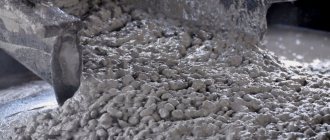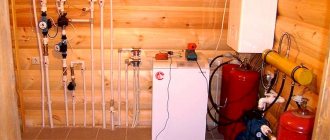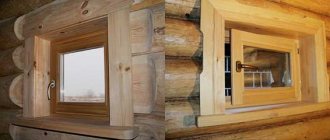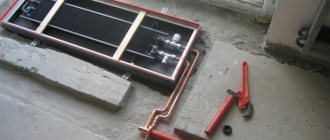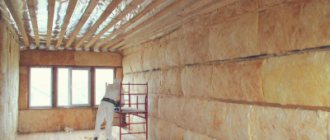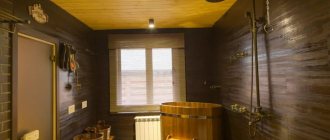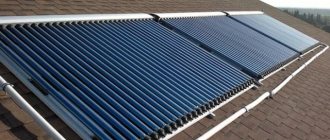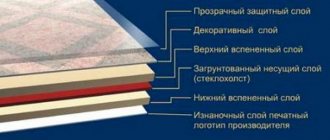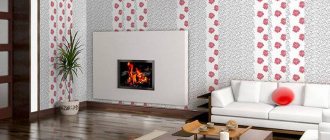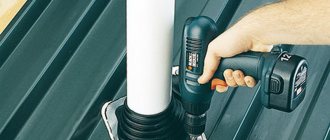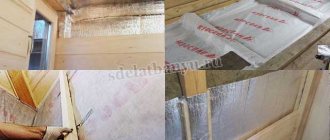Is it allowed to sheathe a house in winter?
It is still better to insulate the facade and cover it with any finishing materials in the summer. During this period, there are many factors that create favorable conditions for the entire process:
- easy to prepare the surface;
- the base is completely freed from excess moisture naturally;
- there are no strong gusts of wind that can tear off insulation or trim;
- The temperature regime is favorable for the installation of panels.
But if there is a need to sheath the house in winter, then this can be done. In this case, it is necessary to adhere to a number of conditions and recommendations that will help keep the materials intact, and the result will be good.
Fasteners and connections
When installing siding, the panels are connected to each other and attached to the sheathing.
There are three types of connections:
- using locks. In this way, panels in adjacent rows are connected. In this case, the lock of the upper panel is hooked onto the receiving part of the S-shaped lock of the lower panel. The connection is snapped carefully, without force;
- with strips, profiles, corners. Such elements have receiving parts into which the edge of the panel is inserted. The resulting joint is covered by the decorative part of the additional element;
- with overlap. Profiles, corner elements, planks can be connected with an overlap when they need to be extended. For ordinary elements you can also use an overlap, but it is better to design their joints using H-profiles. This will increase the rigidity of the cladding for long walls.
Fastening is carried out through factory holes in the nail strips in compliance with the following requirements:
- fasteners can only be stainless (the use of screws, self-tapping screws or nails made of galvanized steel is allowed);
- the leg of the fastener is located in the center of the nail hole;
- The cladding elements are not rigidly fastened. The gap between the siding surface and the fastener head is 0.5-1 mm;
- the leg of the fastener is securely held in the sheathing bar and enters it to a depth of at least 2 cm. The heads of the fastener must be wider than the fastening holes (recommended diameter from 8 mm);
- Together with self-tapping screws, you can additionally use elastic washers;
- if the panel needs to be fixed at a point where there is no factory hole, it is punched with a punch or carefully drilled to the size of standard mounting holes. Driving nails or screwing screws through the siding is not allowed.
At what temperature is it allowed to install?
Manufacturers claim that panels of any type of siding can easily withstand temperature fluctuations ranging from -50 to 50 degrees Celsius. But material that is stored in a warehouse or other premises is much more vulnerable than installed material.
The vinyl version suffers especially. The material becomes very fragile, and even a slight mechanical impact can cause great damage to the panels.
Therefore, if you decide to install siding in winter, choose acrylic siding. It is more plastic and able to withstand such a load. In addition, choose a day when the ambient temperature will not drop below -5 degrees.
If the situation is critical and finishing needs to be done in a short time, the extreme value of temperature indicators can drop to -15 degrees. Although professional craftsmen generally do not recommend working at subzero temperatures.
Features of winter installation
Those who are faced with the issue of siding installation not for the first time know that when installing it, they must leave a gap for expansion. This rule remains relevant in winter. But there is a slight difference. When the temperature drops below zero, the distance from the fastener to the panel, as well as between adjacent elements, should be greater.
If, under positive environmental conditions, a gap of 5-6 mm is left between the starting strips or other adjacent elements, then in winter it should reach 9 mm. The indentation when tightening the self-tapping screw is 1 mm, as in the warm season.
General rules for installing Deke siding
- Use nails or screws designed to withstand harsh environmental conditions. The best option for fastening vinyl panels is galvanized steel or other material that is not susceptible to corrosion. This is due to the fact that the estimated service life of siding exceeds 50 years, and conventional self-tapping screws will only secure the material for 5-6 years. Unprotected nails made of ordinary metal last a little longer, but they also become thinner under the influence of corrosion processes in 15-20 years. The diameter of nails or screws is no more than 3.2 mm, the head is no less than 8 mm.
- To install Deke siding, a lock is provided, the design of which requires some effort to secure the siding parts. After the panel enters the groove until a characteristic click is heard, further impact on the siding is not recommended, as tension in the lock may occur and the temperature gap may decrease. Such an installation error leads to curvature of the Docke siding due to thermal expansion of the material.
- The vinyl siding mounting flange has horizontal elongated holes. Always drive nails or screws exactly into the center of the hole, which serves to compensate for thermal expansion of the material. The siding is fixed on the sheathing in increments of 40-45 cm and 20-25 cm from the accessories, which ensures the necessary rigidity of the structure.
- The gap between the head of the nail (screw) and the siding should be 1-1.5 mm for free movement of the panels at different operating temperatures.
Rice. 12. Fastening vinyl siding panels
What rules must be followed when working with finishing in winter?
It was indicated above that for high-quality cladding of the facade with siding and its insulation from the outside, it is necessary to adhere to a certain set of rules. Now let's look at each of them in detail:
- If the house is icy, no matter if it is wooden, brick or frame, we postpone finishing until spring or summer. It is strictly forbidden to cover such walls with insulation and sheathing. It's a waste of money and time. When the ice begins to melt, moisture will penetrate into the insulating material, which means it will not perform its intended functions.
- It is better to store the panels in a shed or in a warm warehouse. Elements are taken out several at a time as needed. At the same time, the siding will not be overcooled, and therefore retain its plasticity.
- It is better to carry the sheathing with three people so that the material does not sag too much.
- Lay the siding only on a flat surface to avoid the risk of damage.
- Self-tapping screws are used as fasteners. This will reduce the risk of damage to the siding. Plus it's easier to leave a gap. You need to work with a hammer and nails very carefully; even a small blow will damage the part, and adjusting the expansion gap is very difficult.
- To cut the material, choose a sharp saw with fine teeth. If the tool is dull, it will damage the edge of the panel.
- To frame door and window openings, you need to trim and bend the siding; this is impossible to do in the cold. Therefore, take all measurements in advance and prepare the parts in a warm room.
- Let's not forget about our own safety. Comfortable shoes, especially if you need to work on scaffolding. Several pairs of gloves, not only warm, but also comfortable.
Is it possible to cover a house with vinyl siding in winter? - Home owner
This is not a frequently asked question, but it is quite interesting. It is interesting because there are a lot of tips and recommendations for installing siding in winter. Neighbors in their dacha or plot of land talk about this especially passionately. But what is the reality? Are the concepts: winter, frost and siding compatible? siding possible in winter?
Background to the question or the amateur's reasoning
“You’re crazy, who makes siding in winter? It's cold in winter! Freeze! Also, we found the time to build!” - I heard approximately these exclamations addressed to me. Yes, there was still some doubt.
I mentally imagined how the vinyl paneling was crumbling from the frost in my hands, the wires from power tools were cracking and breaking like dry pasta, my fingers were getting cold, the screws were sticking to my hands, they could no longer be torn off my lips, they were frozen. Yes, it’s not a happy and gloomy picture at all...
At the same time, other pictures were drawn. I'm lying in a warm, heated room, my legs are wrapped in a blanket, the quiet music from the stereo system is pleasantly relaxing. When a book about science fiction gets boring, I turn on a cool action movie. It seems that the TV screen is about to explode from explosions and machine gun fire, and they are left to rejoice that I am still alive. I’ll watch the TV series, but then who will comment on the siding in winter - who else if not me!
Practice makes all the difference: it is possible and even necessary!
The first wall with one window was completed very quickly - in one day. True, it was already prepared, wrapped in wind protection, and wooden blocks were stuffed. All that was left was to saw the clapboard and screw it on. It was late autumn, there was no snow yet, and I thought that we would manage before the cold weather. But the second wall, which was not prepared, took two days. Let me remind you that we worked one day off a week.
On two end walls to the gables, two more days for each, and they didn’t notice how winter came into its own. It advanced smoothly, softly, slowly. I had to miss two days off, it was cold. At a temperature not lower than minus 15 degrees Celsius, you can work, but it is advisable that there is no wind. In theory, I thought it would be really cold to install siding in winter. But it turned out that working with vinyl lining was not the most important.
Main difficulties, gables and insurance
Initially, we had to drive 150 meters along a snowy road, you know, to clear it of snow. Once it took an hour and a half to pull the car out of a skid. Improved winter off-road driving experience. Next, it was necessary to clear the driveway and paths on the site, and, having already warmed up, begin siding.
It is convenient to make gables from scaffolding. We were lucky that we didn’t have time to install the second floor windows, so we used their openings to attach the decking. The result was very comfortable and reliable balconies, and a large number of railings, which later served as an additional ladder, increased the safety of work.
Therefore, auxiliary insurance was not needed, it would only get in the way. Climbing up to the level of the second floor and going down is good fitness - it warms you up. And in March, a solarium had already opened, on the south side of the house, the sun warmed up well, and it was possible to partially undress and sunbathe. So the installation of siding in winter was successful!
Flu, winter and my conclusions
My main conclusion: any work, even if it is installing siding, in the winter season is good for health.
The flu wave swept through twice during the winter, but did not affect me. Doctors say that you need to spend more time outdoors in winter in order to get sick less. But they didn’t come up with this, read Jack London, then you’ll understand what’s what!
At the same time, in order not to waste time on instructions, I decided to learn first-hand about practical work with siding. I was interested, asked questions, and this is what experienced people recommended to me.
What good did I learn and what was useful to me?
A few small and fragmentary tips about installing siding yourself. This is not a comprehensive encyclopedia, but I'm sure a few practical tips wouldn't hurt. So…
About siding: which siding is better?
When you ask “knowledgeable comrades”, many recommend Canadian siding. I paid attention to Gentek and Mitten. In all respects, this is an ideal choice in appearance: wood texture, matte color - everything seems to suit it. I also paid attention to our native manufacturers, for example Docke, by the way, nothing, the texture is not as elegant as that of the Canadians, but in general, without looking at it under a microscope, it is very similar.
Sometimes you look at a sample at a construction market or on a site near a large store, and from the long wait for the buyer it has become a little dusty and rather dirty and faded in the sun. At the same time, a rather reasonable thought involuntarily comes to mind: why pay more if in the end you get the same result? After all, over time, both the vaunted Canadian and our domestic ones will become practically indistinguishable, and the fact that the Docke has a less pronounced texture is just a plus - less dust will become clogged!
Well, the price, of course, plays an important role: Docke 110-140 rubles. per m2, Canada 170-220 rub. per m2. My choice is obvious. I bought Docke, the color “cream” is the main color, and under the windows I chose the color “ice cream”. Looking ahead a little, I will say that I am absolutely satisfied with the choice I made.
About self-tapping screws and lining installation
It seems like a very minor detail that doesn’t deserve special attention. But time puts everything in its place, so let’s talk about screws. The screws must be well coated to prevent rusty rivulets from flowing down the walls.
I was looking for information on how siding behaves in winter and summer, and then checked it in practice. Plastic lining - siding tends to change its linear dimensions depending on the ambient temperature, therefore, when fastening it, its free movement must be ensured. If installed correctly in the heat, as it lengthens, it will not hit an obstacle in its path, will not swell, and will not jump out.
The required size of the lining can be cut perfectly with a grinder fitted with a thin disk, just don’t forget to wear a respirator!
Good luck with winter construction (and if you’re interested, read why I love it and whether it’s possible to build in winter)!
Author of the article V.Yu. Belk
Source: https://hozayindoma.ru/stroitelstvo-doma/mozhno-li-obshivat-vinilovym-sajdingom-dom-zimoj.html
Workflow Description
There are no differences in the process of installing siding in winter or summer. They work according to the same plan:
- surface preparation (cleaning, sealing cracks, removing all hanging structures);
- laying a vapor barrier membrane;
- installation of a frame made of wood or metal. Metal is preferable, it is stronger and more reliable than wooden parts;
- façade insulation. Choose a material that is suitable for the base, taking into account the vapor permeability of both;
- laying a windproof membrane. The film will protect the insulation from precipitation, but at the same time let in all the moisture that comes out of the interior;
- installation of a counter-lattice to create a ventilation gap;
- fixing the starting bar. A gap is left between the two elements;
- securing corner elements;
- installation of panels starting from the bottom of the building.
After the panel is installed, be sure to move it from side to side. If this is easy to do, then the installation process was completed correctly. Don’t forget to check with a building level how level the siding is.
Options for winter insulation technologies
It is possible to insulate the facade of a house in winter only in accordance with certain rules. Which technology to use depends on the chosen insulation and finishing material.
"Dry" method
In winter, as a rule, preference is given to “dry” technology. This is due to the fact that during the installation process the use of materials that contain any amount of water is practically excluded. To fix the insulation, metal fasteners or so-called mushrooms (plastic dowels for insulation) are used.
Dry method technology
Several types of heat insulators are more popular as insulation.
- Polystyrene foam and expanded polystyrene have excellent heat-insulating properties. The first one practically does not absorb moisture and does not allow steam to pass through. Expanded polystyrene has zero performance in the same moments. Installation of polystyrene foam is characterized by a large amount of debris, since the material tends to crumble. The insulation is afraid of fire, ultraviolet radiation, acetone, turpentine and drying oil.
- Polyurethane foam has the lowest thermal conductivity coefficient among other insulation materials. It is applied by spraying, so additional fixation does not require the use of fasteners.
- Mineral wool does not deform when temperature and humidity fluctuate and does not burn.
- Basalt and stone insulation do not rot and are not afraid of open fire. Experts consider them the best for winter insulation.
The procedure for facade work includes:
- preparation of the base;
- lathing device;
- insulation gasket;
- covering the structure with a membrane sheet.
This technology allows you to insulate walls built from block products, brick or wood in winter.
The process of insulation using the “dry” method often involves the installation of a ventilated façade. An empty space is created between the insulation and the facing material, which ensures constant ventilation.
This rids the base of excess harmful moisture. This method is more economical than the “wet” one. Among other things, the reason is the opportunity to refuse the services of professionals and do everything yourself.
Insulation using “wet facade” technology
Most construction companies prefer a “wet facade”. It differs in that the thermal insulation is fastened using anchor bolts and plastic dowels. In addition, an adhesive solution is applied to the insulation, and the finished coating is covered with a leveling layer of plaster.
“Wet facade” technology
This solution is suitable for any walls, except for wooden houses and frame-type buildings. The result is lightweight, so foundation load calculations are usually not required.
Despite the justified advantages, “wet” technology is inferior in some respects:
- in winter, it is necessary to observe the minimum thermometer reading at which it is possible to use a particular material;
- the installation process is more labor-intensive and takes longer;
- walls require preliminary preparation: cleaning of protruding elements, dirt and dust;
- leveling the base;
- primer treatment.
Manufacturers, taking into account the possible use of materials in winter, offer to purchase special additives. They allow you to reduce the threshold of acceptable temperature for work to -15°C.
Possible difficulties during installation
It is very important to adhere to all the rules for installing siding not only in winter, but also in summer. If you strictly follow all the recommendations, there will be no difficulties. You need to understand that working at subzero temperatures is quite difficult, so you should prepare for the fact that everything will drag out a little.
Be careful not to leave the panels outside if the forecast calls for precipitation. Under such conditions, the siding will freeze and become even more fragile. If work is not carried out for some time, all materials are hidden under cover.
In some cases, professionals use a heat gun to heat up the siding while cutting pieces. But beginners should not do this, since they can overheat and even set fire to the material.
Is it possible to insulate the facade in winter?
Basic rules for thermal insulation in winter:
- the temperature permissible for working with materials in winter is above +5°C, less often -5°C;
- relative humidity should be less than 65%;
- the speed of wind gusts affects the safety of work;
- strong wind speeds up the drying process of the plaster composition, which negatively affects the quality of the final result.
Any violation of thermal insulation technologies in winter is always followed by a distortion of the result specified by the manufacturer.
Failure to comply with the rules has a negative impact on service life. So, in one winter, materials can become unusable and need to be replaced.
As a result, insulating the facade in winter has its pros and cons. The disadvantages are mostly associated with improper drying of aqueous compositions due to difficult weather conditions. And the advantages are that the walls become insulated from the effects of cold and moisture.
